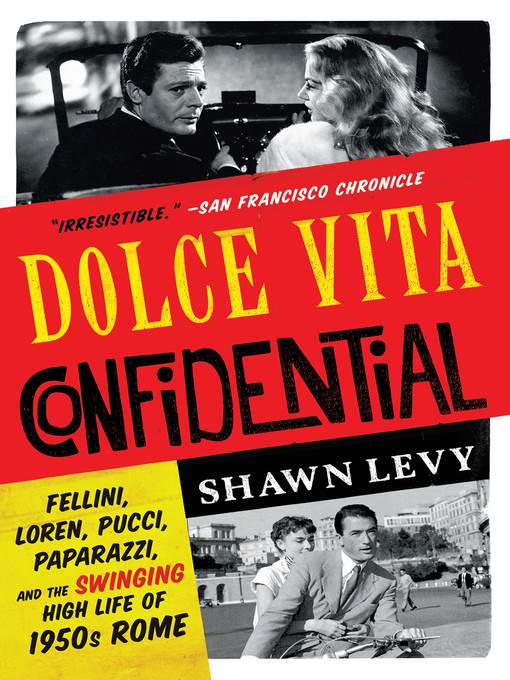
Dolce Vita Confidential
Fellini, Loren, Pucci, Paparazzi, and the Swinging High Life of 1950s Rome
کتاب های مرتبط
- اطلاعات
- نقد و بررسی
- دیدگاه کاربران
نقد و بررسی

August 29, 2016
In this fast-paced, detailed study, film critic Levy (Rat Pack Confidential) turns his attention to Rome in the 1950s and ’60s—a city that, he argues, became the standard for every other cultural hub in the world. This is a grandiose claim, but Levy successfully supports it. He begins with an eclectic portrait of Rome’s rise out of the ashes of WWII into a metropolis: its cafes brimming with artists and writers, its cinema industry swelling from the elaborate patronage under Mussolini, and, in the middle of it all, the emergence of a new professional group, the paparazzi. The occasionally overwrought tone of Levy’s prose is mitigated by his obvious enthusiasm for his subject and the sheer breadth of information. Levy moves from homicide investigations to the history of “Hollywood on the Tiber,” and with the legendary Federico Fellini as a through-line, this becomes a fascinating look at decades of Italian cultural history. Eight pages of photos.

A cultural history reveals an effervescent decade of riches in postwar Rome.In this ebullient tour of Rome in the 1950s, film critic and celebrity biographer Levy (De Niro: A Life, 2014, etc.) portrays the city as a burgeoning center of fashion, photography, and, especially, movies. The star of the book--and the most glittering star to emerge from the period--is Sophia Loren, "the greatest living vessel of any number of traits associated with Italy: sensuality, practicality, endurance, glamour, an ironic sense of humor, a zest for the simple pleasures of life." At first sight, gushes the author, Loren stood out as "one of those superhuman creatures known as movie stars." Loren, though, is not alone in meriting Levy's attention. The author traces Federico Fellini's career from the time he was a journalist to his triumphs as a director, focusing on the conception, casting, and filming of the controversial La Dolce Vita (1960), starring Marcello Mastroianni and Anita Ekberg, and 8 ' (1963), the film that "mixed dream and nightmare and fantasy and real life," and which some critics deemed the director's masterpiece. Others colorfully portrayed in Levy's large cast include actresses Anna Magnani, Gina Lollobrigida (beautiful, but hardly comparable to Loren), Ingrid Bergman, Ava Gardner, Elizabeth Taylor, and Audrey Hepburn; directors Michelangelo Antonioni, Vittorio De Sica, Roberto Rossellini, and Pier Paolo Pasolini; fashion designers Emilio Pucci, Simonetta, and Valentino; and assorted playboys such as Porfirio Rubirosa, who frequented the posh clubs and restaurants on the Via Veneto. That street, and the Trevi Fountain, in which Ekberg famously cooled her feet, mark two of the only sites that Levy describes; physical Rome recedes as he focuses on personalities, careers, and piles of celebrity gossip. To that end, he follows the careers of Rome's famous photographers, dubbed paparazzi after Fellini portrayed them in La Dolce Vita as "a writhing, snapping, shouting mass." Levy's spirited history is nothing less than a love letter to Rome's luxurious, sensational past. COPYRIGHT(1) Kirkus Reviews, ALL RIGHTS RESERVED.

September 1, 2016
In the years immediately following World War II, the city of Rome began a particular kind of resurgence. It not only found its footing economically, it also became the destination from which to take a peek at the sweet life, or la dolce vita. Much of the allure of this famous city grew from the media, specifically the film industry and the paparazzi, who fanatically sought resident film stars, politicians, and anyone who could add a touch of drama to the tabloid press. Levy (King of Comedy; Rat Pack Confidential) brings this vibrant time to life by focusing on, among others, Federico Fellini, Sophia Loren, Marcello Mastroianni, Roberto Rossellini, and all those in orbit around them. The author's style relates a strong journalistic ear, yet clearly Levy is a fan of tabloid gossip. The bibliography even comes with a "films watched" section, an almost definitive selection of movies that document 1950s Rome. VERDICT An enjoyable and informative read about an exciting and colorful period in Roman history and the history of popular culture.--Peter Thornell, Hingham P.L., MA
Copyright 2016 Library Journal, LLC Used with permission.

























دیدگاه کاربران